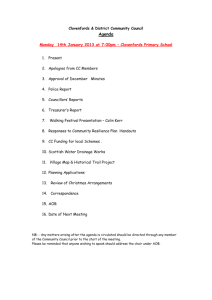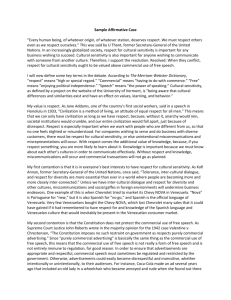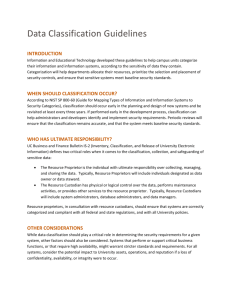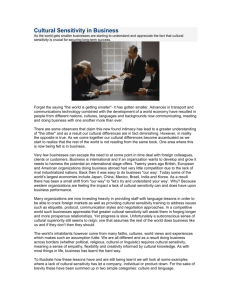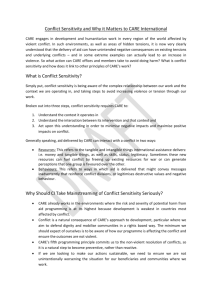Document 7898325
advertisement
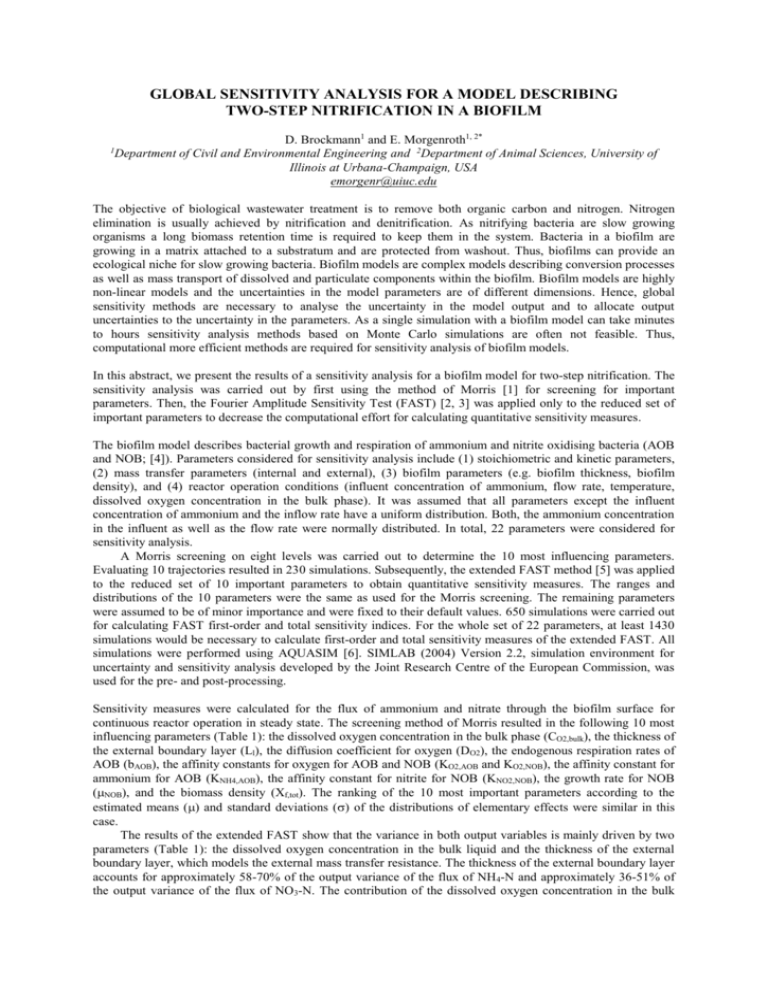
GLOBAL SENSITIVITY ANALYSIS FOR A MODEL DESCRIBING TWO-STEP NITRIFICATION IN A BIOFILM D. Brockmann1 and E. Morgenroth1, 2* Department of Civil and Environmental Engineering and 2Department of Animal Sciences, University of Illinois at Urbana-Champaign, USA emorgenr@uiuc.edu 1 The objective of biological wastewater treatment is to remove both organic carbon and nitrogen. Nitrogen elimination is usually achieved by nitrification and denitrification. As nitrifying bacteria are slow growing organisms a long biomass retention time is required to keep them in the system. Bacteria in a biofilm are growing in a matrix attached to a substratum and are protected from washout. Thus, biofilms can provide an ecological niche for slow growing bacteria. Biofilm models are complex models describing conversion processes as well as mass transport of dissolved and particulate components within the biofilm. Biofilm models are highly non-linear models and the uncertainties in the model parameters are of different dimensions. Hence, global sensitivity methods are necessary to analyse the uncertainty in the model output and to allocate output uncertainties to the uncertainty in the parameters. As a single simulation with a biofilm model can take minutes to hours sensitivity analysis methods based on Monte Carlo simulations are often not feasible. Thus, computational more efficient methods are required for sensitivity analysis of biofilm models. In this abstract, we present the results of a sensitivity analysis for a biofilm model for two-step nitrification. The sensitivity analysis was carried out by first using the method of Morris [1] for screening for important parameters. Then, the Fourier Amplitude Sensitivity Test (FAST) [2, 3] was applied only to the reduced set of important parameters to decrease the computational effort for calculating quantitative sensitivity measures. The biofilm model describes bacterial growth and respiration of ammonium and nitrite oxidising bacteria (AOB and NOB; [4]). Parameters considered for sensitivity analysis include (1) stoichiometric and kinetic parameters, (2) mass transfer parameters (internal and external), (3) biofilm parameters (e.g. biofilm thickness, biofilm density), and (4) reactor operation conditions (influent concentration of ammonium, flow rate, temperature, dissolved oxygen concentration in the bulk phase). It was assumed that all parameters except the influent concentration of ammonium and the inflow rate have a uniform distribution. Both, the ammonium concentration in the influent as well as the flow rate were normally distributed. In total, 22 parameters were considered for sensitivity analysis. A Morris screening on eight levels was carried out to determine the 10 most influencing parameters. Evaluating 10 trajectories resulted in 230 simulations. Subsequently, the extended FAST method [5] was applied to the reduced set of 10 important parameters to obtain quantitative sensitivity measures. The ranges and distributions of the 10 parameters were the same as used for the Morris screening. The remaining parameters were assumed to be of minor importance and were fixed to their default values. 650 simulations were carried out for calculating FAST first-order and total sensitivity indices. For the whole set of 22 parameters, at least 1430 simulations would be necessary to calculate first-order and total sensitivity measures of the extended FAST. All simulations were performed using AQUASIM [6]. SIMLAB (2004) Version 2.2, simulation environment for uncertainty and sensitivity analysis developed by the Joint Research Centre of the European Commission, was used for the pre- and post-processing. Sensitivity measures were calculated for the flux of ammonium and nitrate through the biofilm surface for continuous reactor operation in steady state. The screening method of Morris resulted in the following 10 most influencing parameters (Table 1): the dissolved oxygen concentration in the bulk phase (CO2,bulk), the thickness of the external boundary layer (Ll), the diffusion coefficient for oxygen (DO2), the endogenous respiration rates of AOB (bAOB), the affinity constants for oxygen for AOB and NOB (KO2,AOB and KO2,NOB), the affinity constant for ammonium for AOB (KNH4,AOB), the affinity constant for nitrite for NOB (KNO2,NOB), the growth rate for NOB (NOB), and the biomass density (Xf,tot). The ranking of the 10 most important parameters according to the estimated means () and standard deviations () of the distributions of elementary effects were similar in this case. The results of the extended FAST show that the variance in both output variables is mainly driven by two parameters (Table 1): the dissolved oxygen concentration in the bulk liquid and the thickness of the external boundary layer, which models the external mass transfer resistance. The thickness of the external boundary layer accounts for approximately 58-70% of the output variance of the flux of NH4-N and approximately 36-51% of the output variance of the flux of NO3-N. The contribution of the dissolved oxygen concentration in the bulk liquid to the output variance of the flux of NH4-N and NO3-N is 35-46% and 33-48%, respectively. Hence, determining the thickness of the external boundary layer thickness and decreasing the variation in the dissolved oxygen concentration in the bulk phase would reduce the uncertainty in the model output noticeably. Besides the two parameters mentioned above, the affinity constants for oxygen of the AOB and NOB contribute distinctly to the output variance of the flux of NO3-N. All other parameters account for only 2% and 7% of the output variance of the flux of ammonium and nitrate, respectively based on the first-order sensitivity indices. Note, that the results of the extended FAST are conditional on the choice of the fixed parameters. Table 1: Parameter ranking of the 10 most important parameters according to the sensitivity measures and of the screening method of Morris and first-order and total sensitivity measures of the extended FAST Parameter bAOB KO2,AOB KO2,NOB KNH4,AOB KNO2,NOB NOB DO2 Ll CO2,bulk Xf,tot Morris 8-level 5 7 4 5 10 11 8 8 7 3 11 10 3 4 1 1 2 2 9 9 Flux NH4-N extended FAST first-order total order 0.0008 0.02265 0.0352 0.09164 0.0184 0.27005 0.0003 0.02114 0.0013 0.02224 0.0050 0.05975 0.0043 0.03904 0.5775 0.69893 0.3539 0.45809 0.0128 0.10632 Morris 8-level 6 4 3 3 4 8 9 6 2 2 5 7 11 11 7 9 1 1 8 5 Flux NO3-N extended FAST first-order total order 0.0046 0.0341 0.2174 0.4023 0.1357 0.2374 0.0002 0.0190 0.0061 0.0351 0.0475 0.2540 0.0038 0.0315 0.3557 0.5147 0.3255 0.4777 0.0060 0.0942 Biofilm models can provide results for state variables for the bulk phase as well as for the biofilm matrix. However, most of the state variables can be observed only in the bulk phase of the reactor. Particularly with regard to subsequent parameter estimation, sensitivity analysis of a biofilm model should therefore focus on the state variables in the bulk phase. Screening the parameter space for important parameters and applying a more detailed global sensitivity method only to a reduced set of important parameters is a computational efficient method for calculating quantitative sensitivity measures for models with long execution times. Acknowledgement: This study was supported by a research fellowship to Doris Brockmann from the Deutsche Forschungsgemeinschaft (DFG) under grant No. BR 3556/1-1 and a CAREER award to Eberhard Morgenroth from the US National Science Foundation under grant No. BES-0134104. References [1] Morris MD: Factorial Sampling Plans for Preliminary Computational Experiments. Technometrics 33(2), 161-174 (1991) [2] Cukier RI, et al.: Study of the sensitivity of coupled reaction systems to uncertainties in rate coefficients. I Theory. The Journal of Chemical Physics 59(8), 3873-3878 (1973) [3] Cukier RI, Schaibly JH, Shuler KE: Study of the sensitivity of coupled reaction systems to uncertainties in rate coefficients. III. Analysis of the approximations. The Journal of Chemical Physics 63(3), 1140-1149 (1975) [4] Brockmann D: Modelling Nitrification and Deammonification in Biofilms: Sensitivity Analysis, Identifiability Analysis and Design of Experiments. Veröffentlichungen des Institutes für Siedlungswasserwirtschaft und Abfalltechnik der Universität Hannover. Vol. 135, 2006. [5] Saltelli A, Tarantola S, Chan KPS: A quantitative, model-independent method for global sensitivity analysis of model output. Technometrics 41(1), 39-56 (1999) [6] Reichert P: Aquasim - a Tool for Simulation and Data-Analysis of Aquatic Systems. Water Science and Technology 30(2), 21-30 (1994)



